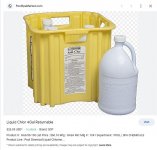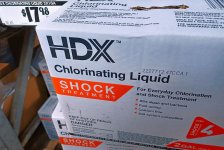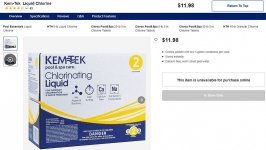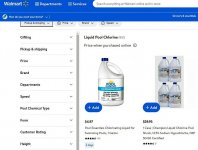a couple weeks ago I paid $9.98 for hdx chlorine from home depot (2 gal). today they want $17.98..... what gives? I get inflation but that's almost 100% increase. plus over the past 2-3 years the price is already jacked up
$17.98 for 2 pack of HDX chlorine from home depot.
- Thread starter mrjetson707
- Start date
You are using an out of date browser. It may not display this or other websites correctly.
You should upgrade or use an alternative browser.
You should upgrade or use an alternative browser.
83 or so 2 packs worth will get you a 40k gallon rated pentair SWG. Its $124 more than the 20k unit so why not get twice the life for $124 ?
It'll last you 8-10 years and pay for itself several times over at these prices. Even if they come down to what they used to be before the world went to crud, it will still pay for itself.
Add one to the renovation.
It'll last you 8-10 years and pay for itself several times over at these prices. Even if they come down to what they used to be before the world went to crud, it will still pay for itself.
Add one to the renovation.
- Jun 1, 2018
- 13,841
- Pool Size
- 26000
- Surface
- Vinyl
- Chlorine
- Salt Water Generator
- SWG Type
- Hayward Aqua Rite (T-15)
It should be illegal to gouge like that! It also should be on sale because it’s probably been sitting there a bit & you would think they wanna get rid of it now that swim season is waning.
Edit- California is still under a state of emergency so price gouging is in fact currently illegal - you can report it. Maybe if more people did & some big retailers got fined they wouldn’t be so quick to double their prices.

 oag.ca.gov
oag.ca.gov
Edit- California is still under a state of emergency so price gouging is in fact currently illegal - you can report it. Maybe if more people did & some big retailers got fined they wouldn’t be so quick to double their prices.

FAQs on Price Gouging
Links to topics below FAQs about Price Gouging in California [for consumers] FAQs on Price Gouging [for local officials] FAQs about Price Gouging in California [for consumers] What is price gouging? Is price gouging illegal in California? When does California’s anti-price gouging statute...
- Jun 1, 2018
- 13,841
- Pool Size
- 26000
- Surface
- Vinyl
- Chlorine
- Salt Water Generator
- SWG Type
- Hayward Aqua Rite (T-15)
Also, look for a Hasa dealer

 hasapool.com
hasapool.com

Find Where You Can Buy HASA Products | HASA
Want to purchase HASA products for your pool or spa? Find out which of our partnered dealers sell HASA Sani-Clor®, Hasachlor®, Classic Bleach and Blue Whale Sanitizer.
titleistseemore
Gold Supporter
Jetson,
found the same thing this past week as we are finishing our pool and will be filling tomorrow. Here is what Found:
This is what I have found after doing some searching ...
1. Walmart Pool Essentials Chlorine 10% Sodium Hypochlorite 4.97 but out of stock.
2. Ace Hardware CDS Brand 10% Sodium Hypochlorite 4.99, my local store shows allot on hand. I went to the store, the shelf price was 5.99 vs the 4.99 on-line price. The store had 13 gallons on-hand.
3. Lowes Pool Essentials Chlorine 10% Sodium Hypochlorite 5.98, they have a pallet (Purchased one-gallon last week)
4. Home Depot HDX brand Chlorine 10% Sodium Hypochlorite 2 gallons 17.98. The local store shows on-hands but too pricey for me.
5. Will check out bleach at Costco but doubt that I will beat the Ace price. (Costco had none)
6. I checked the price of the Hasa Chlorine, the distributor in Stockton was wholesale only but they gave me a pool store that sold their product in Stockton. I went to the small store, 12.5% was $31.00 for a 4 pack. You also pay a $10.00 deposit for the bottles and container. The $10.00 fee is a onetime deposit fee.
7. I checked with various other stores like Target and Tractor Supply but they did not have it or was too expensive.
Here is a great link that I got from mknaus for date codes on chlorine (Check this out)
 www.troublefreepool.com
www.troublefreepool.com
found the same thing this past week as we are finishing our pool and will be filling tomorrow. Here is what Found:
This is what I have found after doing some searching ...
1. Walmart Pool Essentials Chlorine 10% Sodium Hypochlorite 4.97 but out of stock.
2. Ace Hardware CDS Brand 10% Sodium Hypochlorite 4.99, my local store shows allot on hand. I went to the store, the shelf price was 5.99 vs the 4.99 on-line price. The store had 13 gallons on-hand.
3. Lowes Pool Essentials Chlorine 10% Sodium Hypochlorite 5.98, they have a pallet (Purchased one-gallon last week)
4. Home Depot HDX brand Chlorine 10% Sodium Hypochlorite 2 gallons 17.98. The local store shows on-hands but too pricey for me.
5. Will check out bleach at Costco but doubt that I will beat the Ace price. (Costco had none)
6. I checked the price of the Hasa Chlorine, the distributor in Stockton was wholesale only but they gave me a pool store that sold their product in Stockton. I went to the small store, 12.5% was $31.00 for a 4 pack. You also pay a $10.00 deposit for the bottles and container. The $10.00 fee is a onetime deposit fee.
7. I checked with various other stores like Target and Tractor Supply but they did not have it or was too expensive.
Here is a great link that I got from mknaus for date codes on chlorine (Check this out)
Chlorine Date Code Decoder - Further Reading
some of it was dated Sept 29th. another couple boxes were dated June 28thIt should be illegal to gouge like that! It also should be on sale because it’s probably been sitting there a bit & you would think they wanna get rid of it now that swim season is waning.
Edit- California is still under a state of emergency so price gouging is in fact currently illegal - you can report it. Maybe if more people did & some big retailers got fined they wouldn’t be so quick to double their prices.

FAQs on Price Gouging
Links to topics below FAQs about Price Gouging in California [for consumers] FAQs on Price Gouging [for local officials] FAQs about Price Gouging in California [for consumers] What is price gouging? Is price gouging illegal in California? When does California’s anti-price gouging statute...oag.ca.gov
oh you live close to me. I got some hasa for $26 for 4 gals. their pallet arrived today. prob too far to make it worth it for you but it was from aqua pro in pachecoJetson,
found the same thing this past week as we are finishing our pool and will be filling tomorrow. Here is what Found:
This is what I have found after doing some searching ...
1. Walmart Pool Essentials Chlorine 10% Sodium Hypochlorite 4.97 but out of stock.
2. Ace Hardware CDS Brand 10% Sodium Hypochlorite 4.99, my local store shows allot on hand. I went to the store, the shelf price was 5.99 vs the 4.99 on-line price. The store had 13 gallons on-hand.
3. Lowes Pool Essentials Chlorine 10% Sodium Hypochlorite 5.98, they have a pallet (Purchased one-gallon last week)
4. Home Depot HDX brand Chlorine 10% Sodium Hypochlorite 2 gallons 17.98. The local store shows on-hands but too pricey for me.
5. Will check out bleach at Costco but doubt that I will beat the Ace price. (Costco had none)
6. I checked the price of the Hasa Chlorine, the distributor in Stockton was wholesale only but they gave me a pool store that sold their product in Stockton. I went to the small store, 12.5% was $31.00 for a 4 pack. You also pay a $10.00 deposit for the bottles and container. The $10.00 fee is a onetime deposit fee.
7. I checked with various other stores like Target and Tractor Supply but they did not have it or was too expensive.
Here is a great link that I got from mknaus for date codes on chlorine (Check this out)
Chlorine Date Code Decoder - Further Reading
www.troublefreepool.com
I'm confused on what you're saying in that first paragraph. I havnt looked into salt since I'm still waiting for my pool reno but my buddy was saying it's not worth it. something about the salt is bad for your body and the pool equipment. I didn't ask questions. I'm seriously considering it now tho. I'll search on here for pros/cons83 or so 2 packs worth will get you a 40k gallon rated pentair SWG. Its $124 more than the 20k unit so why not get twice the life for $124 ?
It'll last you 8-10 years and pay for itself several times over at these prices. Even if they come down to what they used to be before the world went to crud, it will still pay for itself.
Add one to the renovation.
I found one. paid $26 for 4 gals. they got their shipment today. still expensive IMO but way better than home depotAlso, look for a Hasa dealer

Find Where You Can Buy HASA Products | HASA
Want to purchase HASA products for your pool or spa? Find out which of our partnered dealers sell HASA Sani-Clor®, Hasachlor®, Classic Bleach and Blue Whale Sanitizer.hasapool.com
titleistseemore
Gold Supporter
707,my buddy was saying it's not worth it. something about the salt is bad for your body and the pool equipment.
Sorry, but your buddy is badly misinformed to say the least.

A little logical thinking can prove my point. The salt level in a saltwater pool is about 1/10th of what is in the ocean. If it were bad for you, why do all the people that swim in the ocean not die? Why do people go to saltwater baths which have salt levels higher than the ocean? Why do your salty tears not rot your eyeballs out?
If saltwater pools damaged pool equipment, then why do the three main pool equipment companies, Hayward, Jandy and Pentair, all make salt systems to go with their equipment?
When you get out of a non-saltwater pool you feel like you need to take a shower. When you get out of a saltwater pool, you feel like you just took a shower.
I have three saltwater pools that in 'total' are over 25 years old. I have never had any saltwater issues, and would just as soon fill them in with dirt as have them not be saltwater pools.
Keep in mind that salt cells are consumables. On average, they last 5 to 7 years and then they have to be replaced as they get used up. Another downside is that you might have to run your pump longer to allow the cell to generate the chlorine your pool will need each day. This is only a problem if you still have an old single speed pump. With today's variable speed pumps, the cost to run the pump is no longer an issue. I like to run my pump 24/7, as that allows me to make a little chlorine all the time and to skim all the time. I can do that with my old VS pump for less than $20 bucks a month, and newer VS pumps are even more efficient.
Like any sanitizer system, you still have to routinely test and adjust the system to keep the pool water balanced, but this is very easy to do.
Thanks,
Jim R.
That the 2 pack of chlorine is so expensive, a SWG is a cheaper way to go. Don't EVEN get me started about the convenience. I would pay double and possibly triple for a SWG, because of how easy it makes things.I'm confused on what you're saying in that first paragraph.
But it's thankfully several times cheaper for me. A win-win.
Jim,707,
Sorry, but your buddy is badly misinformed to say the least.
A little logical thinking can prove my point. The salt level in a saltwater pool is about 1/10th of what is in the ocean. If it were bad for you, why do all the people that swim in the ocean not die? Why do people go to saltwater baths which have salt levels higher than the ocean? Why do your salty tears not rot your eyeballs out?
If saltwater pools damaged pool equipment, then why do the three main pool equipment companies, Hayward, Jandy and Pentair, all make salt systems to go with their equipment?
When you get out of a non-saltwater pool you feel like you need to take a shower. When you get out of a saltwater pool, you feel like you just took a shower.
I have three saltwater pools that in 'total' are over 25 years old. I have never had any saltwater issues, and would just as soon fill them in with dirt as have them not be saltwater pools.
Keep in mind that salt cells are consumables. On average, they last 5 to 7 years and then they have to be replaced as they get used up. Another downside is that you might have to run your pump longer to allow the cell to generate the chlorine your pool will need each day. This is only a problem if you still have an old single speed pump. With today's variable speed pumps, the cost to run the pump is no longer an issue. I like to run my pump 24/7, as that allows me to make a little chlorine all the time and to skim all the time. I can do that with my old VS pump for less than $20 bucks a month, and newer VS pumps are even more efficient.
Like any sanitizer system, you still have to routinely test and adjust the system to keep the pool water balanced, but this is very easy to do.
Thanks,
Jim R.
is SWG cost effective any more, when it seems to require a lot more muriatic acid with using SWG? MA is now also $17/2pack at HD. I am considering going back to PUGS and replace 1/2 pool water every year (no acid needed) vs. SWG route (cell cost/electricity/MA cost). At least i think I should turn off SWG for half of the year starting Nov.
C,
I don't use a lot of MA.. I run my TA at 60 ppm and try to keep my pH 7.6 to 7.8.
I have not priced things out lately, but although cell prices have gone up, so have Liquid Chlorine and tablets.
My comments above were more about countering the myths that saltwater pools are 'evil' and not so much about the cost of operation.
I can't foresee a time that I will abandon my saltwater pools. I like the feel of the water better, I like adding a little chlorine all the time. I doubt salt cells increase your electrical bill enough to even notice. I like the ease of maintenance.
That said, it is your pool, and you are free to run it anyway you want. If you think it will work better for you as a tablet pool, then you should go for it.
Thanks,
Jim R.
I don't use a lot of MA.. I run my TA at 60 ppm and try to keep my pH 7.6 to 7.8.
I have not priced things out lately, but although cell prices have gone up, so have Liquid Chlorine and tablets.
My comments above were more about countering the myths that saltwater pools are 'evil' and not so much about the cost of operation.
I can't foresee a time that I will abandon my saltwater pools. I like the feel of the water better, I like adding a little chlorine all the time. I doubt salt cells increase your electrical bill enough to even notice. I like the ease of maintenance.
That said, it is your pool, and you are free to run it anyway you want. If you think it will work better for you as a tablet pool, then you should go for it.
Thanks,
Jim R.
how often do you add salt? or do you not even need to do that because the unit produces it?707,
Sorry, but your buddy is badly misinformed to say the least.
A little logical thinking can prove my point. The salt level in a saltwater pool is about 1/10th of what is in the ocean. If it were bad for you, why do all the people that swim in the ocean not die? Why do people go to saltwater baths which have salt levels higher than the ocean? Why do your salty tears not rot your eyeballs out?
If saltwater pools damaged pool equipment, then why do the three main pool equipment companies, Hayward, Jandy and Pentair, all make salt systems to go with their equipment?
When you get out of a non-saltwater pool you feel like you need to take a shower. When you get out of a saltwater pool, you feel like you just took a shower.
I have three saltwater pools that in 'total' are over 25 years old. I have never had any saltwater issues, and would just as soon fill them in with dirt as have them not be saltwater pools.
Keep in mind that salt cells are consumables. On average, they last 5 to 7 years and then they have to be replaced as they get used up. Another downside is that you might have to run your pump longer to allow the cell to generate the chlorine your pool will need each day. This is only a problem if you still have an old single speed pump. With today's variable speed pumps, the cost to run the pump is no longer an issue. I like to run my pump 24/7, as that allows me to make a little chlorine all the time and to skim all the time. I can do that with my old VS pump for less than $20 bucks a month, and newer VS pumps are even more efficient.
Like any sanitizer system, you still have to routinely test and adjust the system to keep the pool water balanced, but this is very easy to do.
Thanks,
Jim R.
an1vrsy
Bronze Supporter
- Jul 10, 2018
- 1,149
- Pool Size
- 26000
- Surface
- Plaster
- Chlorine
- Salt Water Generator
- SWG Type
- Pentair Intellichlor IC-60
The SWG (Salt water "chlorine" generator) is to make chlorine inside the cell based upon the salinity of the water and the plates in the cell. You add salt separately. You do need to order the Taylor K-1766 salt kit as to test your salt content.
You would add salt at the beginning of the swim season and after any exchange of water, i.e. heavy rain due to overflow, etc. Salt doesn't evaporate but you should manage your salt content by testing and adding when necessary. Yes, most SWG also include a salinity test but TFP always recommends testing separately.
You would add salt at the beginning of the swim season and after any exchange of water, i.e. heavy rain due to overflow, etc. Salt doesn't evaporate but you should manage your salt content by testing and adding when necessary. Yes, most SWG also include a salinity test but TFP always recommends testing separately.
Gary Davis
Well-known member
Attachments
Last edited:
707,how often do you add salt? or do you not even need to do that because the unit produces it?
I add a bag or three of salt each year.
Note that a Saltwater Chlorine Generator (SWCG) makes chlorine and not salt. It is often called a Saltwater Generator (SWG) but 'technically' that is wrong, as it uses the salt in the pool water to make the chlorine that your pool uses each day. In theory the salt does not disappear, but in reality, a little salt has to be added each year.
Thanks,
Jim R.
Saturn94
Bronze Supporter
- Mar 11, 2015
- 1,752
- Pool Size
- 20000
- Surface
- Vinyl
- Chlorine
- Salt Water Generator
- SWG Type
- Hayward Aqua Rite (T-15)
… I have never had any saltwater issues, and would just as soon fill them in with dirt as have them not be saltwater pools.…
Same here! We’ve been using a SWCG with our pool since day one (pool installed in early 2004) with no salt damage to the pool, equipment, or us (as a matter of fact, the added salt seems to make the water easier on our skin and eyes).
Even if using a SWCG turned out to be more expensive than manually chlorinating, I’d stick with the SWCG for the ease and convenience of water maintenance and better feel of water quality. Last I checked though, for us, using a SWCG has turned out cheaper than manually chlorinating.
Jim,
is SWG cost effective any more, when it seems to require a lot more muriatic acid with using SWG? MA is now also $17/2pack at HD. I am considering going back to PUGS and replace 1/2 pool water every year (no acid needed) vs. SWG route (cell cost/electricity/MA cost). At least i think I should turn off SWG for half of the year starting Nov.
Having to add MA with a SWCG is not a given. Many years ago I learned about better managing TA to reduce pH rise. Since lowering our TA target to about 60-70 years ago, pH stays about 7.5 all season. I haven’t had to add MA in many years.
Gary Davis
Well-known member
You hit the nail on the head on the DECISION (based on costs:convenience) for those of us without the SWCG system.Even if using a SWCG turned out to be more expensive than manually chlorinating, I’d stick with the SWCG for the ease and convenience of water maintenance and better feel of water quality. Last I checked though, for us, using a SWCG has turned out cheaper than manually chlorinating.
The SWCG:HASA decision, when based on cost, isn't as simple as that same decision when based on convenience.
For example, I'd love the SWCG convenience. But not the cost.
As far as I can tell, there are three (repeating) cost phases to use a SWCG for sanitation while it's only one (forever repeating) phase to stick with HASA liquid chlorine for sanitation.
We have to weigh the costs versus the convenience of a gallon of bleach once a week (or whatever any given pool requires).
But what worries me most (in making the correct decision), is what the FOREVER cost is for a SWCG (not just the initial or daily cost).
SWCG FOREVER COST:
1. Initial equipment cost (high)
2. Weekly maintenance cost (~zero)
3. Twenty-year depreciation cost (high? low? medium?)
[What is the average SWCG equipment lifetime?]
[What's the average SWCG equipment replacement cost?]
Liquid Bleach FOREVER COST:
1. Initial equipment cost (~zero)
2. Weekly maintenance cost (low) (1 gallon every week perhaps?)
[What is the average HASA liquid chlorine use per week?]
3. Twenty-year depreciation cost (~zero)One other (albeit minor) oddity about SWCG pools is that the specification for TDS seems to go up for no reason.
Why is that?
Why would the TDS limits go up for SWCG pools?
That makes no sense to me in terms of being a range that matters but that's a side note in terms of making the decision to go with SWGC over liquid bleach.
This is an astute observation that the best way to manage the pH is to control it with the alkalinity saturation indices, one huge component of which is the TA (or borates, depending on whether you're working on the pH ceiling or the pH floor).Having to add MA with a SWCG is not a given. Many years ago I learned about better managing TA to reduce pH rise. Since lowering our TA target to about 60-70 years ago, pH stays about 7.5 all season. I haven’t had to add MA in many years.
As I understand the complex TA/CH [1:3 or even 1:4] calculation taking costs into account, it's likely "better" to lower the TA from the start (which usually means a few gallons of HASA muriatic acid may be required, unfortunately) which means the inexorable rise in pH (due to inevitable carbon dioxide outgassing) will have a lower ceiling.
Last edited:
Thread Status
Hello , This thread has been inactive for over 60 days. New postings here are unlikely to be seen or responded to by other members. For better visibility, consider Starting A New Thread.





